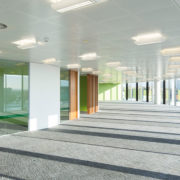Fascinating year in store for office market
It is extraordinarily difficult to make predictions given the macro-economic uncertainty, particularly here in Scotland.
As many have already commented, we have the “double whammy” of Brexit and the possibility of Indyref2, with both creating volatility in the broader Scottish economy and with investors’ views on new speculative development in the office sector.
“The difficulty in securing funding for major office development is a real issue” – Phil Reid
For the first time in my long career there are no new speculative office developments under construction in Glasgow, with most cranes being for hotel or student accommodation.
As we begin the new year, the relatively low level of enquiries in the Glasgow office mid-market, when combined with the oversupply of high-quality refurbished space, could suggest a market that’s struggling. This perhaps doesn’t tell the full story though. This sub-sector is a difficult market but there is room for optimism. A good proportion of Glasgow SME businesses appear to be growing profitably and recruiting, which should in turn lead to take up of space as they invest in larger or better offices.
A sizeable percentage of these businesses seem to be from “new industries” including the media sector, where entrepreneurial leaders are looking for offices that reflect their youthful and forward-looking business culture and brand.
As the British Council for Offices (BCO) has commented, these businesses are keen to explore the benefits of co-working and a more flexible working style. Whilst this must remain at an affordable cost and won’t suit everyone, there is a clear growth in this type of office operation and interior fit-out.
The difficulty in securing funding for major office development is a real issue, particularly in Glasgow where there is a rapid absorption of the remaining larger (30,000 sq ft plus) floor plates. It is quite possible that this position will not change in the next year, which will in turn see more refurbished former grade A buildings taking centre stage. Whilst new developments offer a blank canvas to “be best in class”, the BCO and its members have been part of the evolution of office refurbishment so that many “recycled” buildings are now subject to very detailed assessments prior to carefully crafted and expensive wholesale upgrading.
In recent times, buildings’ systems and designs have been moving more towards allowing occupiers of all types to fit out in a variety of styles to accommodate all manner of operational styles. The intention is that the building plays its part in generating a commercial advantage from what is usually a sizeable office relocation investment.
The fastest growing trend is that of “wellness”. In this hurly burly, quick-moving technological age, employers are becoming increasingly aware that to maximise their people’s productivity – and recruit and retain the best talent – the organisation and its buildings must provide the facilities to work healthily. In the UK our culture is to work hard and long hours so this more rounded approach seems to be very appropriate. Buildings in locations with the easiest commute, the best cycling and leisure facilities, good natural light and refurbished or built to provide an energy-efficient, flexible and comfortable working environment seem likely to be the best placed going forward and the BCO’s continually evolving “best practice” standards seem set to continue to be the workplace design benchmark. The old adage that “property is all about occupiers” means that the workplace is changing very fast to reflect the needs of these occupiers. Even putting aside global and UK political factors, the commercial office property market sector in 2017 is set to have its ups and downs as always but it may well be a fascinating year.




